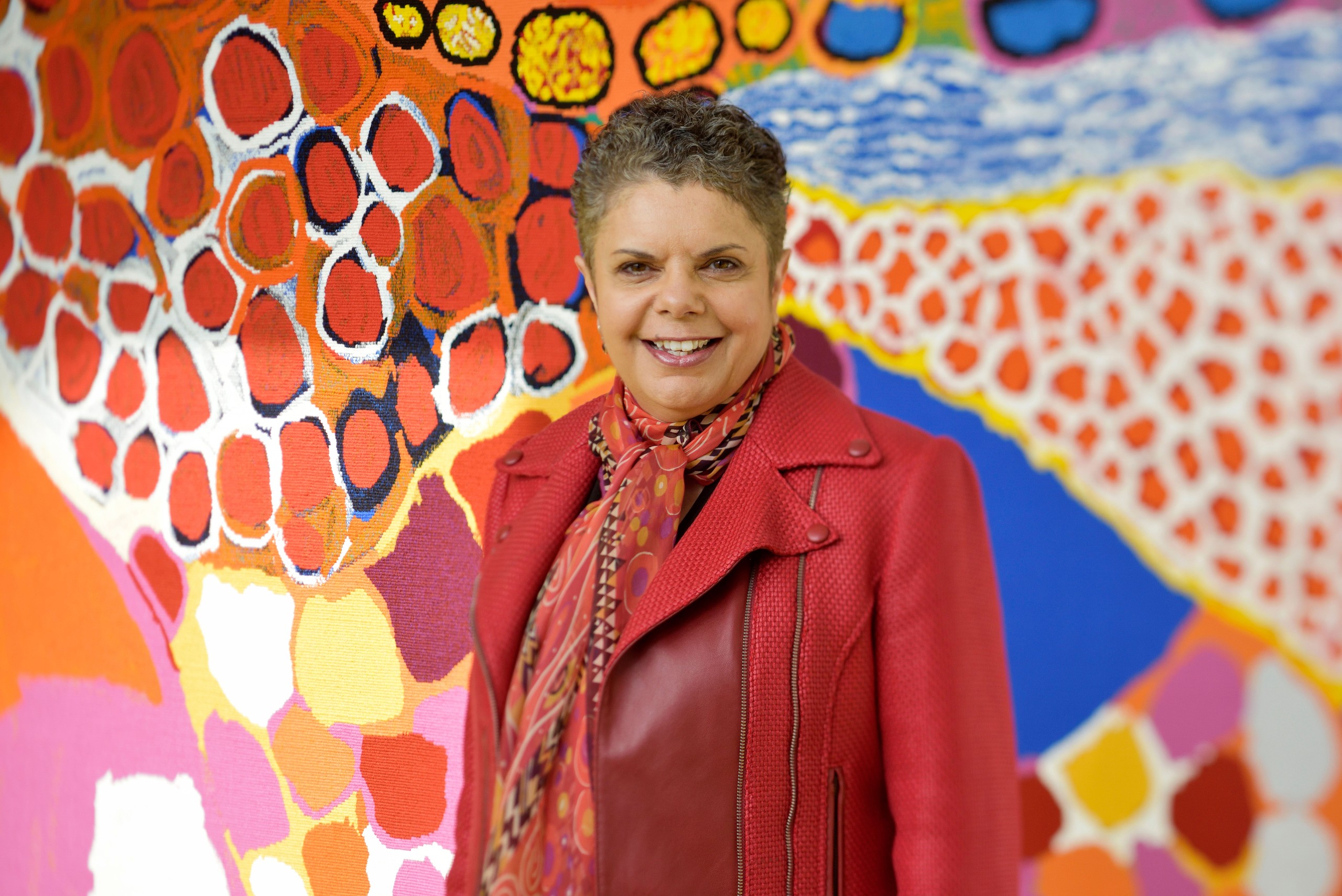This has to be the most complex and serious event in thís year’s Sydney Festival. Placed on the day before the contentious Australia Day and thus ‘energised’ as a Vigil event, the component parts included five of the Australian Tapestry Workshop’s Indigenous artworks created for Australian embassies around the world, music composed around them by Deborah Cheetham, who also sang her heart out, top musicians from both the MSO and SSO plus some interesting oriental additions, a series of designer gowns that the ATW has somehow linked to the project (mulitply worn, of course, by Cheetham), and a small team of Indigenous music trainees who made a brief appearance.
Was it the Department of Foreign Affairs idea, the Tapestry Workshop’s or fashionista Linda Britten??? The program suggests the ATW as prime mover. Which raises the first question in my mind as to how they selected these artworks to send to the world. They are not by any means the finest each artist produced.
But the evening’s complexity was undoubtedly Ms Cheetham’s effort. I can’t resist reprising her program biog: “Deborah describes herself as a 21st Century urban woman who is Yorta Yorta by birth, stolen generation by government policy, soprano by diligence, composer by necessity and lesbian by practice”.
Having first encountered her in 1997 as a ‘White Baptist Abba Fan’, the lady has moved a long way on to opera (her Short Black Opera company), to winning an AO, to discovering a Yuin ancestry in NSW which allowed her to include a work celebrating the immortal Gulaga mountain with its ceremonial women’s rocks, and finally, she announced, to moving to Sydney.
Perhaps inevitably, as an urban woman, she began her tapestry sequence with Brook Andrew’s ‘Catching Breath’. His repurposed 1900 photo of an unnamed warrior from Armidale must beg questions in Singapore – though such questioning was matched by Cheetham’s text which consisted mostly of the insistent postulate, “My Name?”, resolved, perhaps, by a concluding, “My Country”. Also questionable was the picturing on screen of only part of the completed tapestry – just the original photo, to which Andrew had very deliberately added veils over the face through which the warrior’s eyes glinted. The ATW had woven them separately.
Elizabeth Marks Nakamarra’s ‘Creek Bed’ gave Cheetham an opportunity to play with her repurposed title, ‘Above Knowing’. For of course Nakamarra painted her work on the ground, taking an aerial view of Country. But, designed for the Embassy in Paris which is sited on a gathering place for Jews about to be sent to Auschwitz, the composer wondered whether DFAT was “above knowing” about that horror, as many Australians are above knowing about Aboriginal massacres. The combination gave the soprano an excuse to sing Article 5 of the UN Declaration of Human Rights in Pintupi (not Pitjanjatarra, as the film’s script suggested).
Patrick Mung Mung had also “gifted” Cheetham the Gija words that accompanied his ‘Ngargooroon’ painting. She interpreted his work as both “teeming” and “dislocating” – a pretty accurate clash of Kimberley conditions for the Gija, though both the art and the music seemed to have a domesticity that just ain’t a match for the worn grandeur of that timeless place. Impressively, the ATW managed to capture the texture of Mung Mung’s ochre brushwork in their wool.
What I had discerned as a slight orientalism in Cheetham’s music to this point took specific form for Pedro Wonaeamirri’s ‘Pukumani’ work. A guzheng came forth and suddenly the neat lines in the artwork looked a match for the Chinese instrument’s strings. And the bowing of those strings produced a deep resonance that was a match for the depths of any Arnhem songman.
Even more successful was the sorrowing cry of the Japanese shakuhachi that spoke to the land in Daisy Andrews’s Walmajarri landscape, ‘My Mother’s Country’. For when I wrote Andrews’s obituary in 2015, I found this explanation from her that totally undermined the picturesqueness of her desert mountain scenery:
“When I paint I think a lot about my mother and father when they were living in the desert. I was crying at Kaningarra. People were killed there, policemen killed the people. That’s why my parents left. I didn’t see my grandparents. I knew that country in my mind from my brother Boxer. That country is empty now. It made me cry. I tell you I was just upset. I didn’t say anything, I just stood there and looked at that country. When I draw my pictures I am seeing that country in my head. When I am painting I tell my grandkids these stories.”
Did Cheetham’s strident soprano add anything to the effective emptiness in her instrumental score? I’m not sure. But congratulations to her on the concept and for much of the music – played superbly in various combinations by the likes of Diana Doherty, Monica Curro, Philip Arkinstall, Catherine Hewgill et al.



